I’ve got a Fender Stratocaster, one of the infamous “Splatter Stats“. Purely stock except for the strings, it’s always had a couple of quirks that I’ve wanted to address. It’s time.
I use Ernie Ball Super Slinky strings and the G string in particular has always sounded a bit on the dull side. It’s because of the way the string passes through the nut. One can brighten up the open string by dampening it a little between the nut and the tuning peg (but it’s inconvenient to play that way). I keep the tremolo bridge free-floating, which makes tuning somewhat more challenging. I don’t use the whammy bar but I sometimes ‘wobble’ the sound with my palm on the bridge. Once in tune it tends to stay in tune but lots of bendy work will tend to detune the bendy string. I chalk that one up to string friction.
Graph Tech makes what they call a Supercharger Kit that seemed like just the ticket. [addendum June 2013: Graph Tech has revised their product numbering and web site since this post was written. The link to the kit now points to the updated product. The biggest apparent difference is that my string trees are black with squared-off corners. They probably have a little more string contact.] [updated again November 2019: They’ve gone and changed their website again, so the link is updated. Here’s the part number I used: PN-8000-00] The kit includes a set of saddles, a replacement nut and nut blank, and string trees. The kit also includes an Allen key for setting string height, some emery paper for nut shaping, plus instructions. Oh, yeah, and a pick. You can read about their claimed benefits on their Web site.
The Graph Tech parts that contact strings are made of a material that promises to self-lubricate, leading to less string breakage according to their literature. I was hoping that by reducing friction, bends would return to original tune more consistently. Finally, others on the net had mentioned my preferred strings when discussing the Graph Tech nut. My shop isn’t equipped for cutting new nuts. I don’t want to invest in a set of seldom-used nut files so the closer I get to a stock nut the better.
The work is easy, but quite a bit of setup is necessary after swapping the parts around. If you’re not comfortable setting string heights and intonation then you’ll be better off having your tech do the work instead. If the setup is incorrect your instrument will sound bad. Very bad.
Here’s my Strat on the floor ready for supercharging, using the kit of parts shown. You can click these images for a better look.
The stock saddles have been removed and the Graph Tech parts are ready for installation. The instructions tell you to remove the strings but I wanted to keep them a little longer; I only changed them a week ago. Since they were all loose, though, this was an excellent opportunity to clean the fretboard and other areas that aren’t often so fully exposed. (When I change strings I change them one at a time in order to keep the neck tension reasonably constant.) So these won’t be seated right and I expect setup will be harder that it would be with new strings. So it goes.
Graph Tech saddles installed, though obviously not adjusted. Some say the black parts don’t look as good as the stock chrome but I disagree.
The stock nut removed. I was ready for battle but mine literally fell out with a little bit of thumb pressure. Normally you’ll want to score the lacquer around the nut with a sharp Xacto blade so it doesn’t crack. This could explain why I’ve always felt the nut was just a tad low; the shop may have modified it before selling it. (Or, maybe what was sold as new was actually a return that had been set up?) According to the serial number, the guitar I bought August 14, 2004 was built in the Ensenada, Mexico plant in 2003-2004.
Here are the stock and Graph Tech nuts. Note the tab on the Graph Tech – some Strats have a receiver for that tab and some don’t, I’m told. The string slots are not as deep. The new nut is a little longer than stock; I needed to remove the tab and shorten it a little, removing equal amounts of material from each side. It was easy do do using the emery included in the kit.
In the shop, a Dremel tool held by the rubber-jawed vise next to the lathe made the work of removing the tab easy. After the tab was removed, the thickness of the nut was reduced by hand to make for a snug fit in the nut slot. Then the bottom of the nut was reduced – by hand, a little bit at a time, tuning to pitch in between – to set the nut height. The supplied instructions give a good starting point but I set it a little on the high side. I’m conservative that way, figuring I can always lower the nut in the future. Raising the nut means ordering a new one and starting again.
The nut’s in place and you can see the new string trees as well. Yes, now there are two string trees! What’s not evident in the photo (my bad) is that the trees are different heights. The bottom one’s shorter and guides the high E and B strings – exactly like the stock tree. Graph Tech supplies a second, taller tree in the kit. I thought about it for a long time before placing it as I did. The additional tree guides the G string but isn’t low enough to touch the B string at all. I didn’t want the tree to touch the D string because I felt it would make the nut-to-tree angle too severe. I’m not sure how the extra tree will hold up long term, guiding only one string, but we’ll see. I drilled the pilot hole for the new screw with a 0.058-inch bit chucked in a hand drill.
Here’s the finished product. You can see the black replacement parts and the extra string tree. The setup and intonation are roughed in, good enough to start playing. I know me – it’ll a period of time of adjusting to get it just the way I like it – and I may need to further lower the nut – but so far it looks like a huge success!
The instrument tunes easier and stays in tune better despite long bends. The G string now rings true! The overall sound is decidedly different. The unamplified sound is louder and brighter. Amplified, you immediately notice the increased sustain.

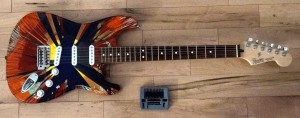
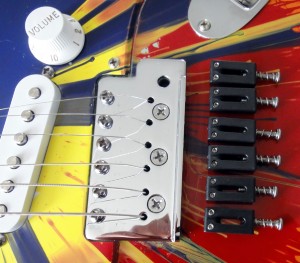
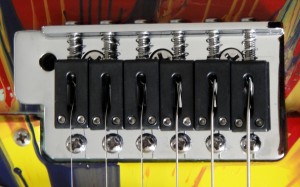
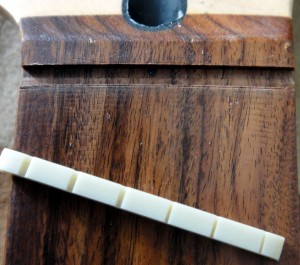
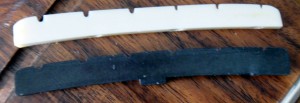
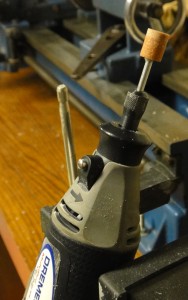
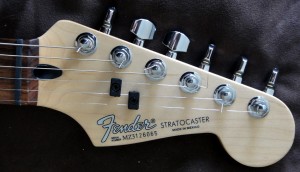






I’ve bought lots of gizmos over the years because of the hype, only to be disappointed. IMHO, GraphTech saddles are the only guitar mod that is worth the money (actually, they’re worth much more!). I have them on a Les Paul and my problems with string breakage ended immediately after installation.
I think manufcaturers should include string saver saddles as original equipment.
Could be a graphite composite. According to their FAQ, the nut is “a proprietary material which is precision engineered under high pressure and heat. It is impregnated with Teflon throughout so it reduces the friction between the nut material and the string.” Typically, composite materials are manufactured in exactly that way.
The material is easy to work with and shapes well with fine-grit sandpaper. I’m not sure how that’ll hold up long-term. I’ve never noticed nut wear from string abrasion, this stuff seems softer so it may be the first. Of course, that will probably take years to show itself and more years to present a problem. Meanwhile I’m liking it.
It’s definitely slippery to the string – no binding. Each tuning machines produces a smooth and predictable pitch response.
I originally set out to find a new nut, one I could more-or-less drop in without making it myself from a blank. I’m glad now that I sprung for the whole kit.
Thanks for the props and additional links, Cyberschnook. (Hmm, I wonder what would happen if I got Nut Sauce in my Sexwax?)
And feel free to link or repost my article!
Nice work!
I wonder if Graph Tech implies graphite? If not, look into Big Bend’s Nut Sauce. If you don’t find it nearby, I know stewmac.com (Stewart-MacDonald) has it.
Also check out http://bluesguitarunleashed.com/ and get on the mailing list. Somewhere along the line, he’ll probably be pushing courses at a big discount. You’re past Beginning Blues Guitar (starts with how to hold a pick), but you might find Blues Guitar Unleashed, Solos without Scales, and the forthcoming music theory course interesting.
Meanwhile, I’m going to check if the forum is limited to course customers, or anyone can join. This blog entry definitely would fit into “Gear Talk.”
I agree, BTW, that the contrast between the black saddles and chrome tailpiece looks good!